I decided to explore some of the New German Cinema films and have started with Paris, Texas, a film directed by Wim Wenders and released in 1984. It follows the story of Travis Henderson who has been wondering around in the desert for four years. When he emerges from the desert he is unable or unwilling to speak at first. His brother comes to fetch him and take him home to Los Angeles where Travis’s seven year son, Hunter, has been living with his brother and wife. As the film progresses Travis forms a relationship with his son and they go off together to find Travis’s ex-wife, Jane. They find her working in a seedy peep show joint on the outskirts of Houston. Travis speaks with Jane through the peep show telephone and at first does not reveal his identity but on a second visit tells her his part of the story of their break up. Jane then, also through the telephone explains her part. Travis is not able to meet her face-to-face but tells her that her son needs her and that he is waiting in a hotel in the city. Jane goes to the hotel room and is reunited with Hunter. Travis watches this reunion from a parking lot across from the hotel. The movie ends with Travis driving off leaving Hunter and Jane together.
The story is interesting in that there are only five characters of any significance in the movie; Travis, his son Hunter, his wife Jane, his brother Walt and his sister-in-law Anne. It is a view of American life as dysfunctional and isolating.
I’m not sure what the correct term is for the mise-en-scene of this movie, but the settings and locations can best be described as minimalist. Many of the outdoor scenes involve vast stretches of open desert or landscape with big blue skies.
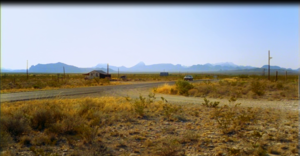
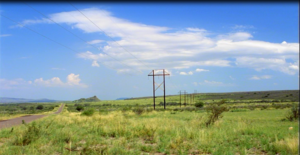
Some of the buildings in the desert don’t look completed, they almost just the skeletons of the structures that they could be. The image below is of the outside of a bar – it’s just a block!
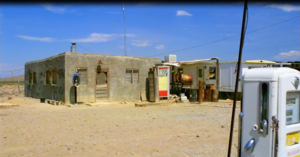
When the action is taking place indoors, the settings are devoid of details – quite stark rooms, plain curtains, empty tables, etc. It appears as if the director has wanted to par the mise-en-scene down to only what is essential.
The use of colour and lighting in the film adds a layer of sub-text that helps to give the story its meaning. There are two colours that repeat throughout the movie; red and green.
When the colour red is used, either in the lighting, the clothing, the setting or the props, it seems to indicate that some form of extreme emotion or emotional danger is present even if the acting is understated.
When Travis first arrives at Walt’s house, Hunter is seen playing in his room whilst listening to Travis talk with Walt and Anne. The curtains in his room are red and dominate the shot – indicating emotional danger for both Hunter and Travis. Later when they are all talking in the dining room and Walt brings up a holiday trip that Travis does not remember; the blinds behind Travis are red – yet again raising the danger that Travis might remember this holiday and that it will cause him emotional pain.
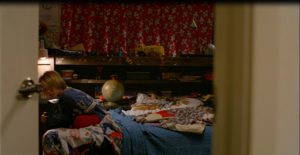
In one of the scenes before Travis goes to Houston, he is speaking with Anne about his rage. The scene starts with the red garden lights casting intermittent red shadows on Travis but has he gets more intense and stands up to go lean on a small wall, his face and Anne are completely washed in the unnatural red light.
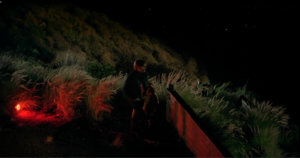
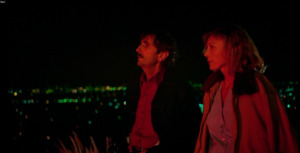
When Travis and Hunter leave LA to go find Jane, they decide to phone Walt and Anne to tell them what they are doing so that they don’t worry. When Travis and Hunter go to the call box to make the call, the scene is coloured by a neon green coloured light. When the scene then cuts to the Walt and Anne in their kitchen, the same greenish light is present. I wonder if the green light is supposed to act as a signifier that even though what is happening is awful (after all, a seven year old boy has been taken from the only home he know) it will not lead to great danger. It’s hard to be sure what this means because at the end of the movie it is unclear if Hunter is going to go back to Walt and Anne. Wim Wenders in the commentary to the movie explained that the green lighting in this scene was a result of the existing green neon lights and that they had been advised to replace these neon’s with colour corrected lights, but he liked the unusual effect of the light and decided to keep it and not try any colour correction either.
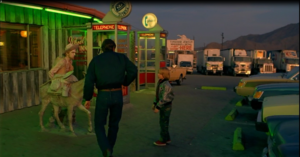
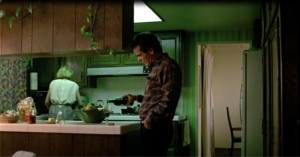
Travis and Hunter then go on the trip to Houston together to find Jane. When Travis finds her and has to come to terms with the fact of her working in strange themed peep show joint, he gets drunk and later that evening Hunter has to take him back to where they are staying. Both Hunter and Travis are wearing red shirts – an indicator that the scene is a highly charged emotional scene, even though on the face of it, the conversation is very calm and controlled.
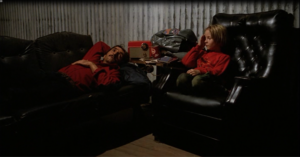
When Travis first goes into the building where Jane works and he doesn’t know yet what sort of place it is, the red light as he goes up the stairs is a blinding indicator that he is heading into serious emotional danger.
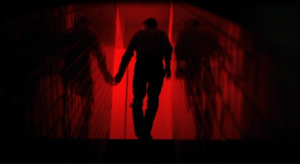
Later, when Jane meets Hunter in the hotel room, it becomes clear as they get closer to each other that they are wearing the same coloured green shirts – indicating a type of harmony and resolution. Outside, the windows of the building opposite are also coloured green. Travis is standing outside in the parking lot and he is also bathed in a green light, hopefully indicating that he has found some peace in seeing son and mother reunited.
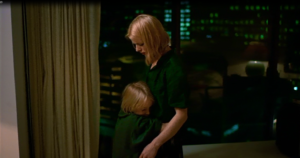
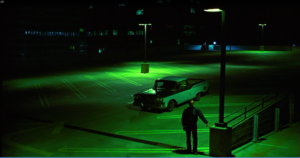
However, as he drives off you see him washed in red from the red lights of the cars on the highway, which creates uncertainty for the viewer as to whether Travis has in fact found peace.
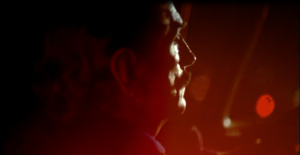
There is one amazing cinematically stunning shot towards the end of the movie. Travis is talking to Jane using a phone. There is a one way glass between them. Up until this point, Travis has had his back turned to Jane because it is too hard to tell his story while looking at her. However, at the point that Jane works out who is talking and comes close to the one way glass to try to peer through it, Travis turns and faces the glass. As he does so, his face reflecting off the glass is superimposed on Jane’s face. It is a staggering powerful shot. Wim Wenders explained that this shot was just luck, they had not been expecting it to happen but when it did, they immediately recognised its power.
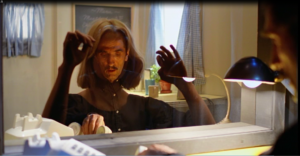
Filmography:
Paris, Texas [feature film and commentary to the feature film, DVD] Dir. Wim Wenders. Road Movies Filmproduktion, Argos Films, Westdeutscher Rundfunk (WDR), USA, 1984. 147 min.
